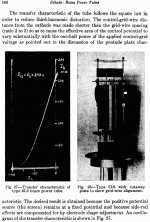Hi,
What is square law in tube amp/pre amp stage?
How can we get range/region of square law for some known valves, e.g. 5687, 7119, 6072, 12AU7 etc? I can not determine this in the datasheet/load curve.
And what is the effect on sound signature, distortion etc?
Thanks,
Ervin L
What is square law in tube amp/pre amp stage?
How can we get range/region of square law for some known valves, e.g. 5687, 7119, 6072, 12AU7 etc? I can not determine this in the datasheet/load curve.
And what is the effect on sound signature, distortion etc?
Thanks,
Ervin L
May I ask you to show me this tube square law? I've been doing this for quite a long time, have a couple of degrees in this stuff, and I have no idea what you are referring to.
Aloha,
Poinz
AudioTropic
Aloha,
Poinz
AudioTropic
What is square law in tube amp/pre amp stage?
Idunnow. The only square law device I'm aware of is the FET. VT's are more like one-and-a-half law devices.
the only ^2 law I have come across involves the rate at which $ get spent.
COme to think of it, its actually logarithmic...
COme to think of it, its actually logarithmic...
the only ^2 law I have come across involves the rate at which $ get spent.
COme to think of it, its actually logarithmic...
Yes I think it is logarithmic, with odd peaks of noise usually centred around hi-fi shows or DIY articles. Quite a controversial issue with wives and girlfriends too sometimes.
Also in general valve stuff at shows tends to be about 5-10x more expensive than solid state, and as a rule the more you regress technology toward the 50's (transformers, tubes, paper cones, alnico etc) and the less components used the more the price increases too.
Some valves, such as ECC82/12AU7, do have a part of their gm characteristic which is a reasonable approximation to square-law. EC90/6C4 too (=half an ECC82), which is why it is used as an RF mixer.
Look on the data sheet for a plot of transconductance versus grid voltage (not all sheets have this). Pick a bias point where this is roughly a straight line. Use a very low anode load resistor - much smaller than usual, as you want to avoid any linearising feedback from the anode voltage.
Look on the data sheet for a plot of transconductance versus grid voltage (not all sheets have this). Pick a bias point where this is roughly a straight line. Use a very low anode load resistor - much smaller than usual, as you want to avoid any linearising feedback from the anode voltage.
Schade claimed it so for RCA 6L6 at the very least.
Total idiot's speculation here, no facts involved:
I suspect its carefully shaped remote cutoff of Gm?
May or may not be square in the larger sense, but
only what happens in AB crossing really matters.
I don't know how faithfully this feature is copied in
off-RCA-brand clones?
Total idiot's speculation here, no facts involved:
I suspect its carefully shaped remote cutoff of Gm?
May or may not be square in the larger sense, but
only what happens in AB crossing really matters.
I don't know how faithfully this feature is copied in
off-RCA-brand clones?
Remote cutoff valves have a roughly exponential response - just like a BJT!!
The OP didn't say what he wants a square-law response for. An effects box, or a communications receiver mixer? These are the only useful things to do with it.
The OP didn't say what he wants a square-law response for. An effects box, or a communications receiver mixer? These are the only useful things to do with it.
For tube without square law, you can reshape Gm
(reduction by NFB) by placing a square law diode
under the cathode.
A stack of Schottky diodes, FET or small MOSFET
that has been strapped as a diode. These have
square law function. But you need make sure the
square law diode function is scaled appropriately
for your quiescent current. A diode too big won't
curve the signal enough to matter.
I like Schottky, no recovery glitch as it turns on/off.
See Post#97 this thread:
http://www.diyaudio.com/forums/tube...mendations-10w-ch-version-10.html#post2275023
(reduction by NFB) by placing a square law diode
under the cathode.
A stack of Schottky diodes, FET or small MOSFET
that has been strapped as a diode. These have
square law function. But you need make sure the
square law diode function is scaled appropriately
for your quiescent current. A diode too big won't
curve the signal enough to matter.
I like Schottky, no recovery glitch as it turns on/off.
See Post#97 this thread:
http://www.diyaudio.com/forums/tube...mendations-10w-ch-version-10.html#post2275023
Last edited:
- Status
- Not open for further replies.
- Home
- Amplifiers
- Tubes / Valves
- Tube Square-Law, what and how to set up?
